| |
 CELIA THAXTER CELIA THAXTER |
|
|
|
|
| |
Price: $250.00 |
Stock# 2723 |
| |
THAXTER SENDS HER POEM “MAIZE FOR THE NATION’S EMBLEM”
CELIA THAXTER (1835-1894). Thaxter was a New England poet and author.
ALS. 1pg. 5” x 8”. March 31, 1893. No place. An autograph letter signed “C. Thaxter” to Mrs. Goodwin: “I send you this grandmother’s literature & the Maize, with much love to you all from your affectionate C. Thaxter”. The Thaxter poem “Maize for the Nation's Emblem” was first published in May 1893 in New England Magazine. The letter has a central fold and is in fine condition. |
2723
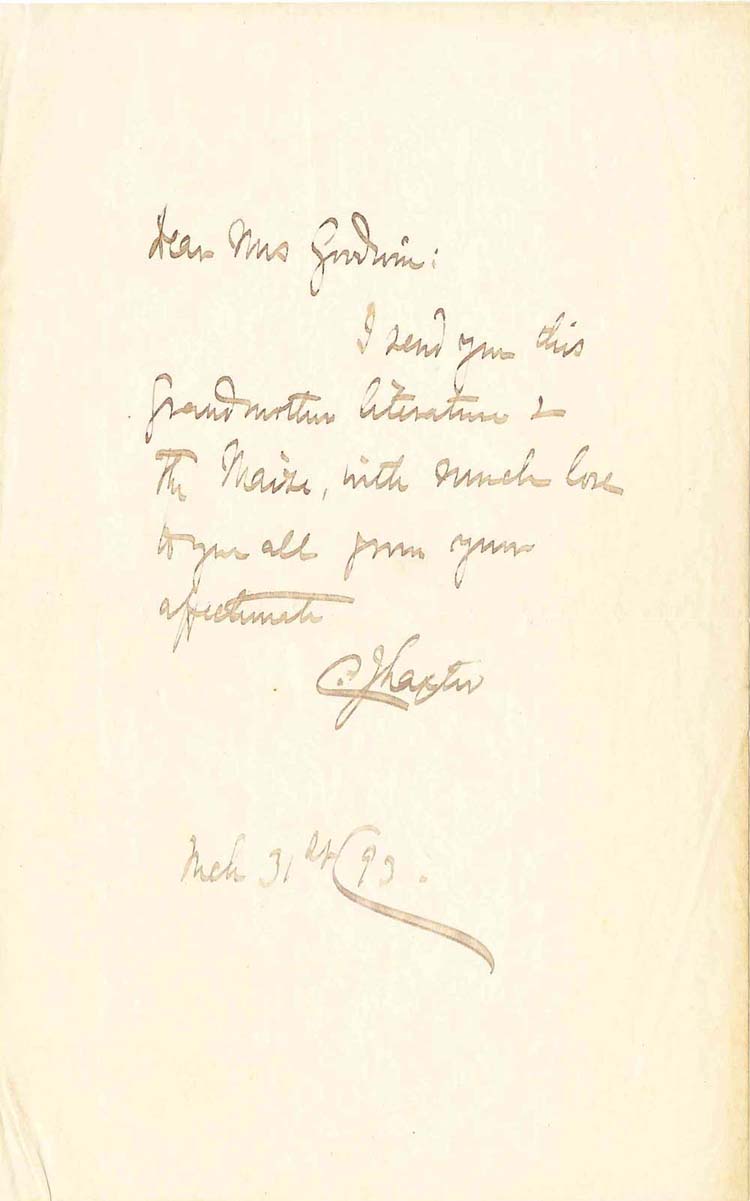
|
|
| |
| |
 ALICE TOKLAS ALICE TOKLAS |
|
|
|
|
| |
Price: $750.00 |
Stock# 6251 |
| |
HAND-WRITTEN LETTER FROM ALICE TOKLAS JUST MONTHS AFTER THE DEATH OF HER LOVER, GERTRUDE STEIN: “JUST THE LETTER GERTRUDE WOULD HAVE LIKED”
ALICE TOKLAS (1877-1967). Toklas was an American-born member of the early-twentieth century Parisian avant-garde.
ALS. 1 pg. 8” x 10”. September 12, 1946. 5 rue Christine. An autograph letter signed “Alice Toklas” to “Dear Tony”: “Just the letter Gertrude would have liked - thanks for writing it to me. In haste I’m sending you Carl Van Vechten’s address in New York – 101 Central Pak West- ring him…Endicott 2-8748 and o to see him if you have time. I have written to him about your first chapters. Basket and I are looking forward to seeing you soon”. Alice Toklas had a nearly-four-decade long romance with fellow American expat, novelist and playwright Gertrude Stein (1874-1946). Together, they hosted a literary salon in Paris at their home at 27 rue de Fleurus, frequented by other American expats in Paris like Ernest Hemingway, F. Scott Fitzgerald, Paul Bowles, Thornton Wilder, and Sherwood Anderson, as well as avant-garde painters like Picasso and Matisse. In 1933, Stein published her memoir, The Autobiography of Alice B. Toklas, written in Toklas’ voice, a literary bestseller that vaulted Stein from relative obscurity into the mainstream literary world. Today they are buried side-by-side in Paris. However, because their relationship, though an open secret, had no formal standing, Stein’s family denied Toklas access to paintings and other items deeded to her in Stein’s will. Carl Van Vechten (1880-1964) was a patron of the Harlem Renaissance and the literary executor of Gertrude Stein’s estate. The letter was sent to Tony Scott, an up-and-coming writer with Variety. The letter also references Basket, Toklas’ and Stein’s poodle. The letter is written on thin stationery paper and is in fine condition. |
6251

|
|
| |
| |
 HARRY TRUMAN HARRY TRUMAN |
|
|
|
|
| |
Price: $1,500.00 |
Stock# 5608 |
| |
PRESIDENT TRUMAN WRITES TO RUTH BRYAN OWEN, AMERICA’S FIRST WOMAN AMBASSADOR: “I AM FAMILIAR WITH YOUR GREAT INTEREST IN THE UNITED NATIONS AND YOUR EFFORT TO INFORM THE AMERICAN PEOPLE ON THE NECESSITY FOR AN ASSOCIATION OF NATIONS FOR PEACE”
HARRY TRUMAN (1884-1972). Truman was the Thirty-Third President.
TLS. 1pg. 7” x 9”. October 5, 1949. The White House, Washington. A typed letter signed “Harry S Truman” as President on “The White House” stationery. Truman wrote to Ruth Bryan (Owen) Rohde, the famous daughter of William Jennings Bryan: “I can’t tell you how very much I appreciated your good letter of September thirtieth. I am familiar with your great interest in the United Nations and your effort to inform the American people on the necessity for an association of nations for peace. I know you will do an excellent job.” Owen was twice elected to the House of Representatives and was the first woman appointed as an ambassador when FDR, in 1933, sent her to Denmark and Iceland. After World War II, she attended the San Francisco Conference that established the United Nations and, in 1948, President Truman made her an alternate delegate to the United Nations. The letter is in very fine condition with a horizontal mailing fold. |
5608
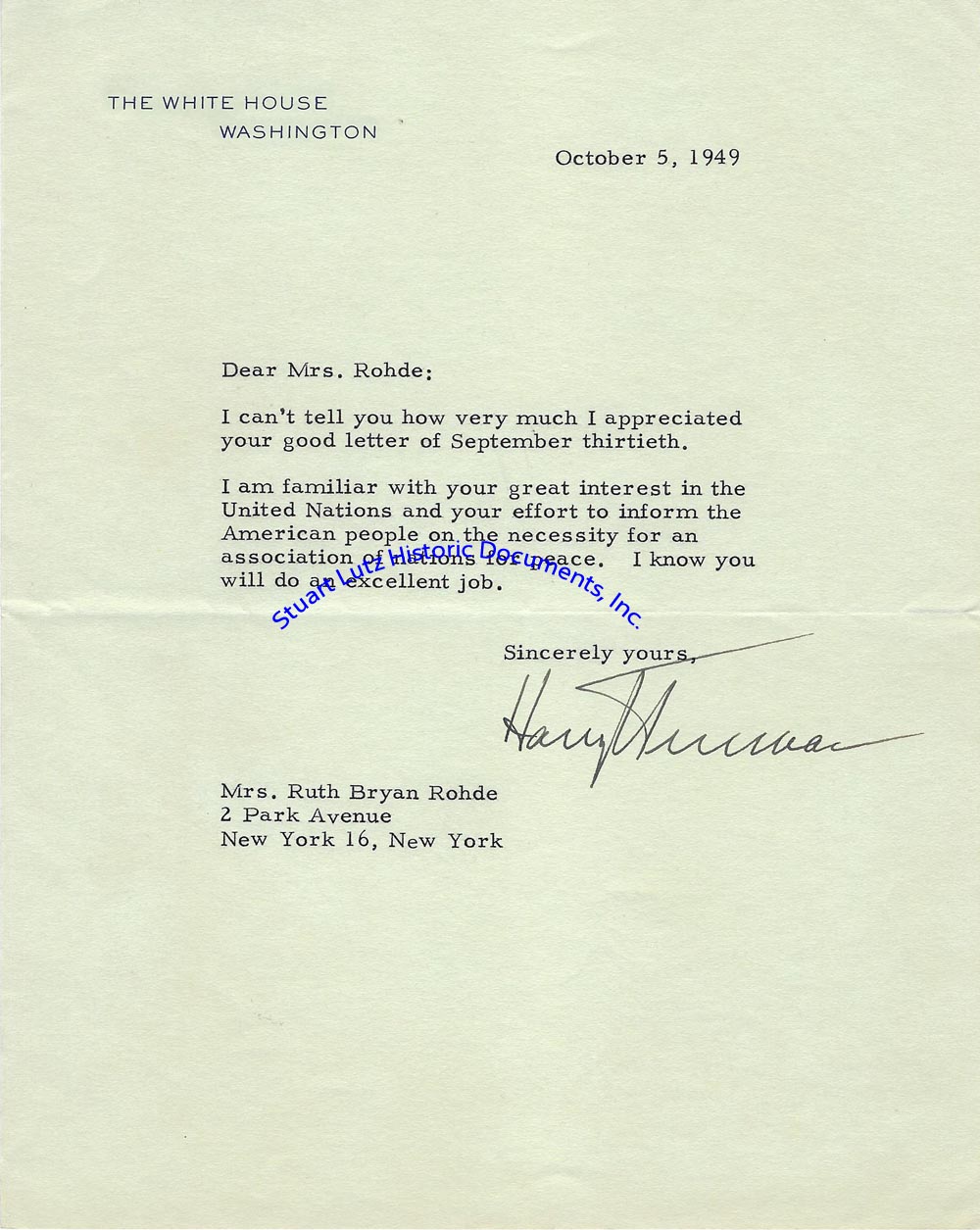
|
|
| |
| |
 SOPHIE TUCKER SOPHIE TUCKER |
|
|
|
|
| |
Price: $150.00 |
Stock# 6076 |
| |
“THE LAST OF THE RED-HOT MAMAS” SOPHIE TUCKER INVITES NEW YORK FEMALE JOURNALISTS TO A PARTY: “THE ONLY ONES I BELONG TO ARE NIGHT CLUBS”
SOPHIE TUCKER (1886-1966). Tucker was a Jewish-American singer, comedian, actress, and radio personality known for her risqué vaudeville and nightclub performances.
TLS. 1pg. 8”x 10”. N.d. New York. A typed letter signed “Sophie Tucker” to “New York Newspaper Women”: “I hear you’re trying to build a new clubhouse. I don’t know much about clubs because the only ones I belong to are night clubs. I’ve only known two newspaper women very well – Amy Leslie and Nellie Revell – but the rets of your newspaper girls are like them, your club will also be a night club. And here’s hoping it never gets padlocked. Your party the other night was a real joy to me. I was sorry I couldn’t stay longer but I had to get back here to crack the ice and squeeze the oranges. Speaking of that, I wonder if you wouldn’t like to come over to my Playground to make mud pies with me next Monday night. But take your baths before you come because this is a cabaret and not a bathhouse. If you get hold of any wine around here, remember it is for internal use only. I’m not using this party for publicity purposes. You won’t be exploited…just a little opportunity to get better acquainted with you…” This letter reveals the symbiotic relationship in the early twentieth century between female newspaper reporters and performers, especially women, as both jockeyed for equality in male-dominated fields. Both Leslie and Revell were pioneers, with Amy Leslie serving as one of the few women drama critics of her time, contributing to the Chicago Daily News, while Nellie Revell was among the first to successfully have her work treated equally with her male colleagues and not relegated to the “women’s page.” The letter is in fine condition. |
6076
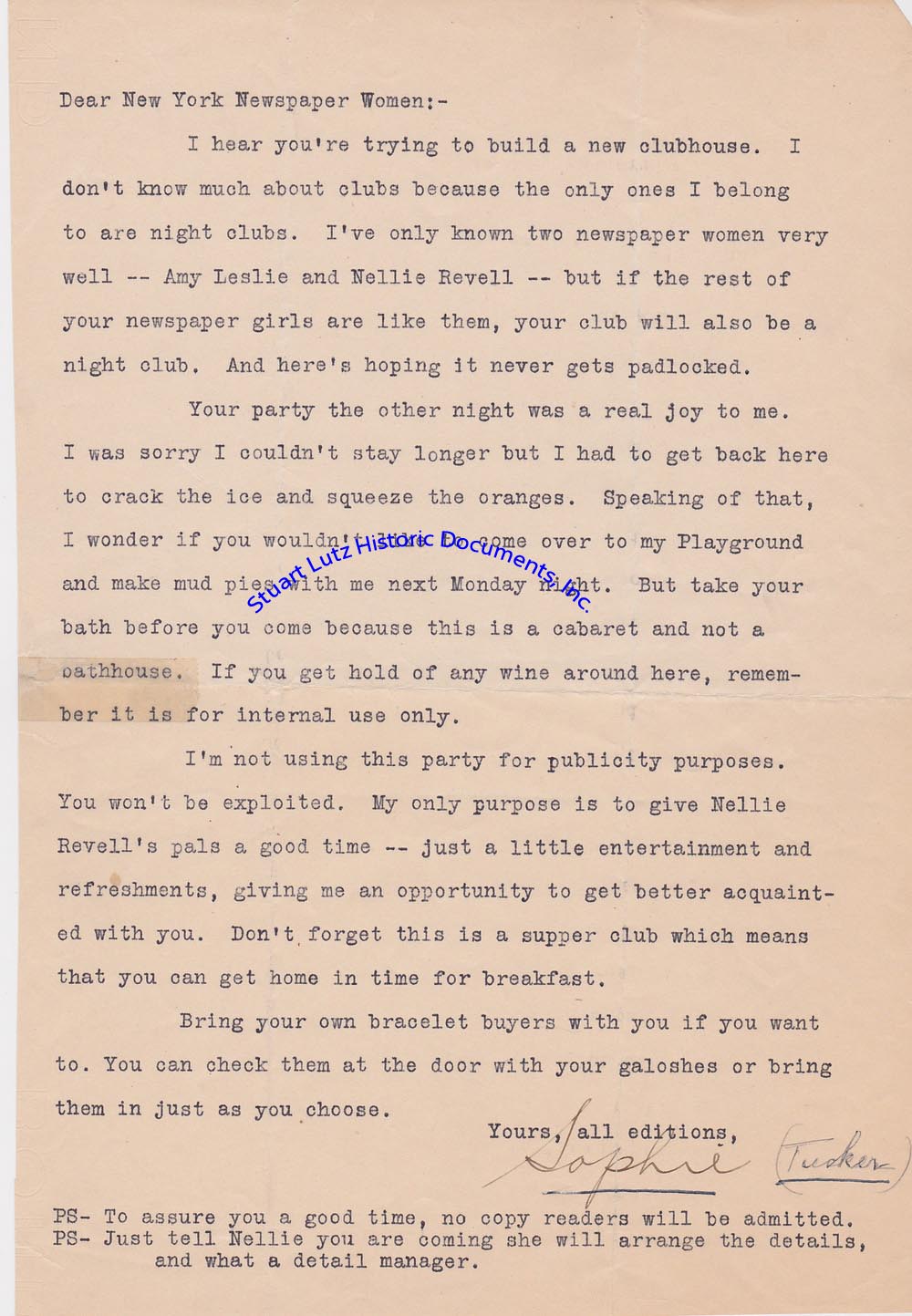
|
|
| |
| |
 TASHA TUDOR TASHA TUDOR |
|
|
|
|
| |
Price: $250.00 |
Stock# 4932 |
| |
CHILDREN’S BOOK AUTHOR TASHA TUDOR WRITES ABOUT HER FAMILY – “I WISH THEY WOULD STAY LITTLE TWICE AS LONG AS THEY DO”
TASHA TUDOR (1915-2008). Tudor was a children’s book author and illustrator.
ALS. 2pgs. 6” x 8”. October 20, 1949. New Hampshire. An autograph letter signed “Tasha Tudor”. Tudor wrote to a reader about acquiring originals from Oxford Press and also about her family: “It was so pleasant to again hear from you, your heartwarming enthusiasm for my work fills me with such happiness. I am writing to Oxford Press about your request for an original now and at Christmas time. Would you be good enough to pay them and then they can reimburse me, it is easier to do it in that way. Your two little girls must be growing fast as all children do. I wish they would stay little twice as long as they do. Our children are all well and flourishing…We have six children now, as a very dear friends of mine is living with us until her house is made livable…We are also busy with our marionettes which we make and perform with. Tomorrow we are going to Manchester N.H. for the first show of the season. With best wishes to you. Sincerely Tasha Tudor”. It is in fine condition with dark ink. |
4932
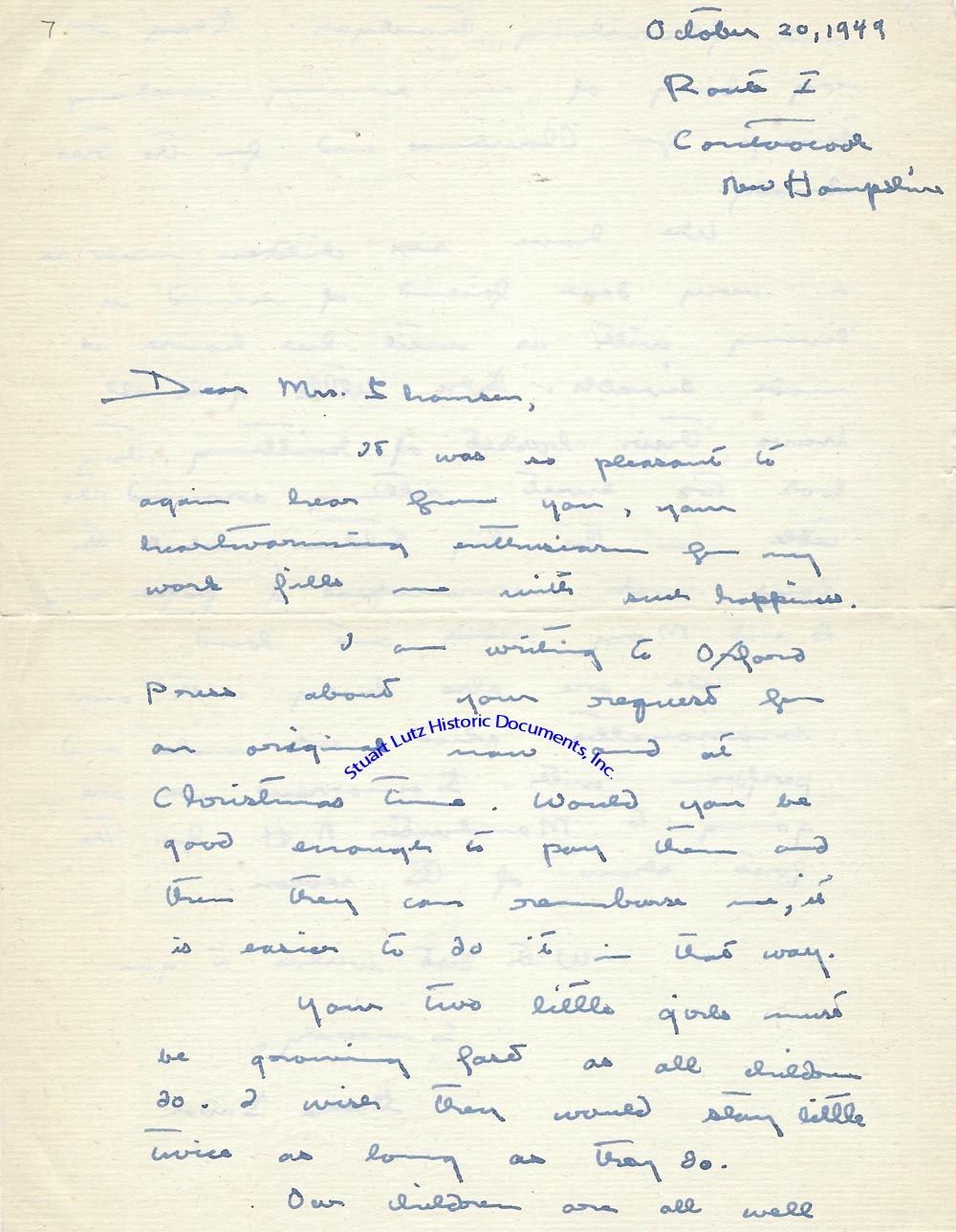
|
|
| |
| |
 PAULE VEZELAY PAULE VEZELAY |
|
|
|
|
| |
Price: $250.00 |
Stock# 5758 |
| |
BRITISH-BORN PAINTER PAULE VEZELAY TALKS ART THEORY, QUOTES HENRI MATISSE AND JEAN ARP
PAULE VEZELAY (1892-1984). Vezelay was a British-born abstract painter active in France.
HOWARD RUSSELL BUTLER (1856-1934). Butler was an American artist who wrote Painter and Space, a book about artistically depicting solar eclipses.
TLS. 2pgs. November 4, 1941. Bristol, England. A typed letter signed “Paule Vezelay”. During World War Two, Vezelay wrote to American painter Howard Russell Butler about his book, Painter and Space. Vezelay was clearly very interested in and knowledgeable about art theory, and she responded eagerly to Butler’s own theories as presented in his book. She also quoted modern artists Henri Matisse and Jean Arp. However, she seems not to have realized that Butler had died seven years before the date of her letter. “… How much I wish I might have the opportunity of meeting you, of exmplaining [sic] my own theory for the scientific composition of pictures and of asking you to help me with your collaboration should you be interested in my ideas. As this is impossible at present, I would like to ask your permission to quote parts of your work, with, of course due acknowledgements. I must add that, while I think these theories of great importance to the artist, and agree that ‘the technique of exmression, [sic] must have a scientific basis’ as you say in your Preface, yet I am inclined to think that these theories should not always be followed in a hard and fast manner, There is the element of emotion which we can hardly measure in a scientific sense and just those qualities also, which make a person an artist rather than a scietist. [sic] If it was otherwise there seems to me no doubt that colour photography might be developed in such a way that anyone with the suitable training might arrive at making first class ‘pictures’ on scientific lines. What does Matisse say of this ---‘A true artist cannot see colour which is not harmonious. He should not copy the wall, or objects on a table, but he should above all express a vision of colour, the harmony of which corresponds to his feeling- And, above all, one must be honest with one’s self. and Jean Arp, ‘Art is a fruit growing out of a man like a fruit out of a plant, likr [sic] the child out of the mother. While the fruit of the plant assumes independant [sic] forms and never strives to resemble a helicopter or a President in a cutaway, the artistic fruit of man shows, for the most part, ridiculous ambitious to imitate the appearance of other things. I like nature but not it’s [sic] substitute.’ Much has been written by so many interesting artists but not one, I think, would disagree that there are certain laws which must always be observed. Perhaps the question lies in knowing how best to use those laws to serve one’s own purpose as an artist, and in this, a knowledge of some scientific theories must surely be useful…”. It is in very good condition, with minor wrinkling. |
5758
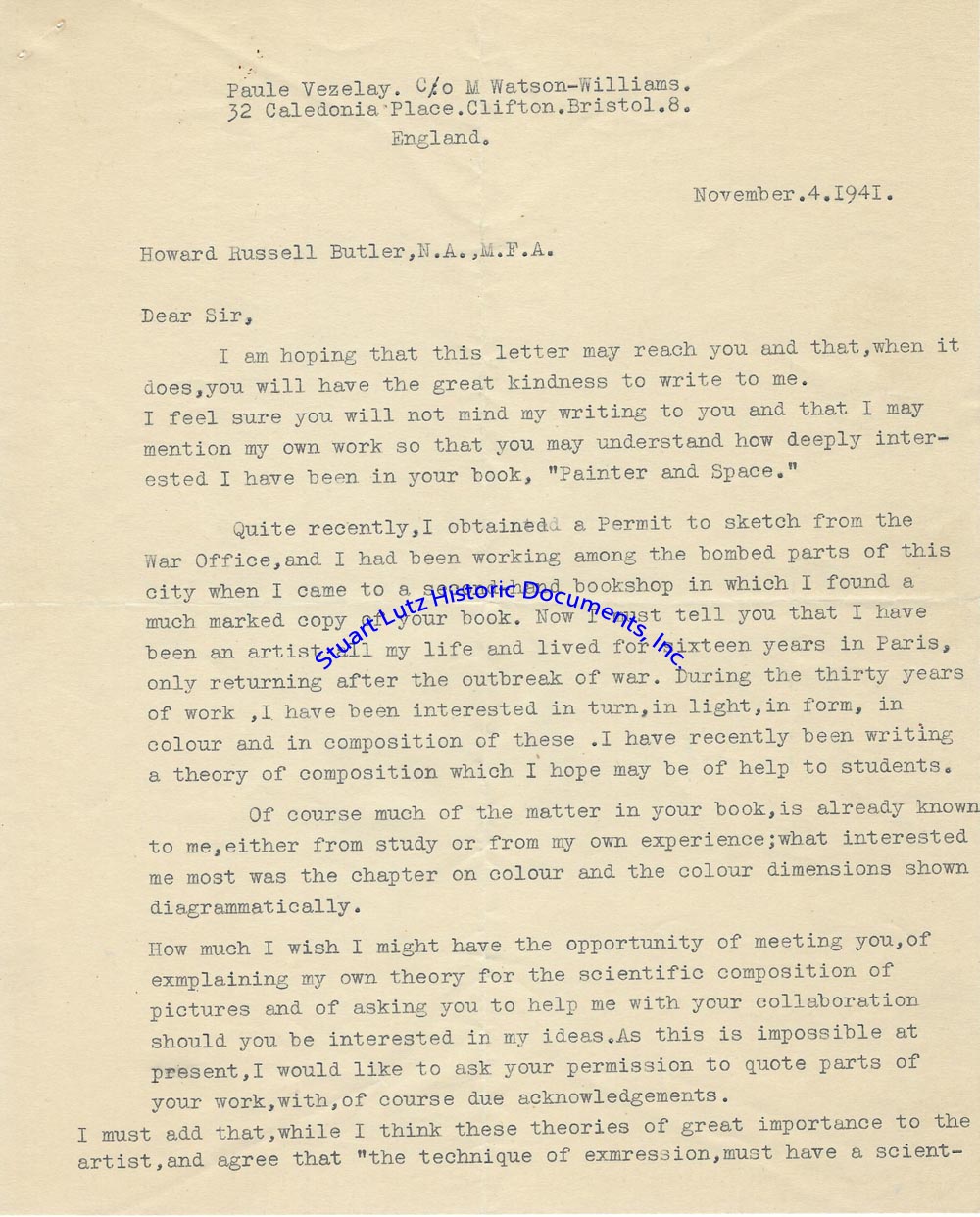
|
|
| |
| |
<Previous 6>
|
 |






